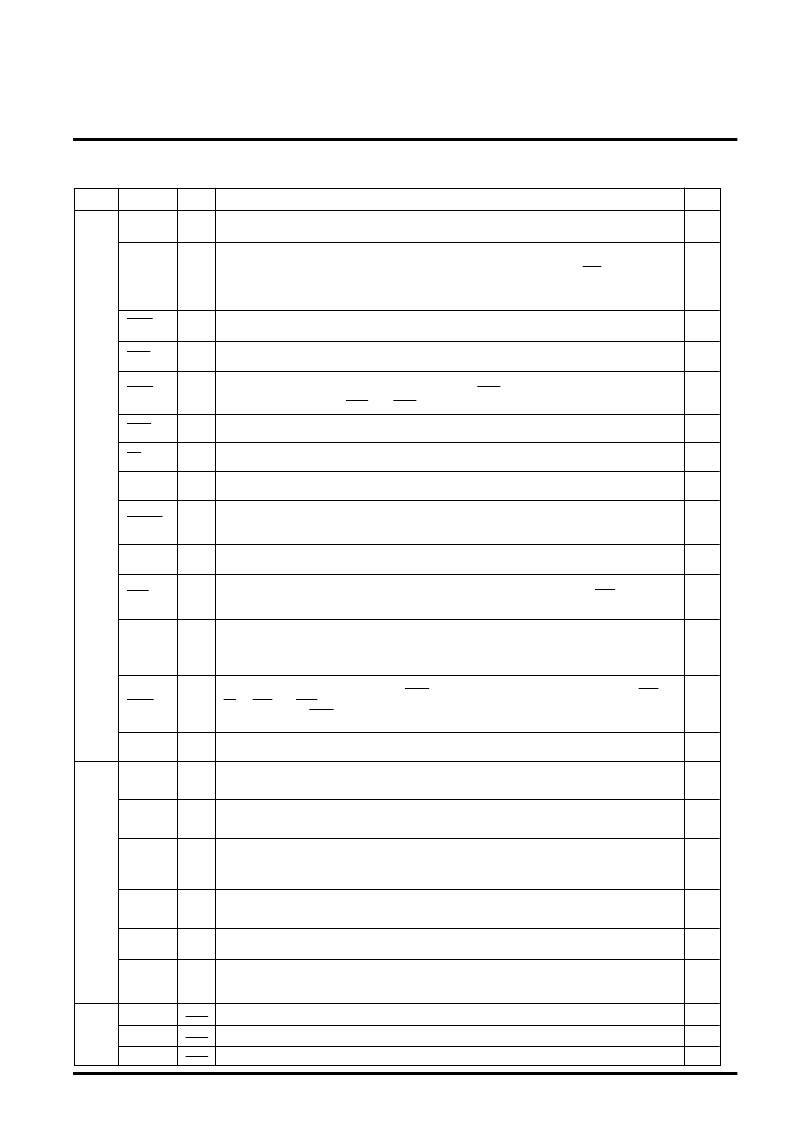- 您現(xiàn)在的位置:買賣IC網(wǎng) > PDF目錄370992 > M66272 (Mitsubishi Electric Corporation) LCD CONTROLLER with VRAM PDF資料下載
參數(shù)資料
| 型號: | M66272 |
| 廠商: | Mitsubishi Electric Corporation |
| 英文描述: | LCD CONTROLLER with VRAM |
| 中文描述: | 液晶顯示控制器顯存 |
| 文件頁數(shù): | 3/4頁 |
| 文件大?。?/td> | 78K |
| 代理商: | M66272 |

LCD CONTROLLER with VRAM
M66272FP
MITSUBISHI <DIGITAL ASSP>
PRELIMINARY
Notice: This is not a final specification.
Some parametric limits are subject to change.
PIN DESCRIPTIONS
N.C
No connection
5
12
V
SS
Ground
7
V
DD
Power supply pin
Pin name
Input/
Output
Input/
Output
Function
Number
of pins
D<15:0>
MPU data bus
When selecting 8 bit MPU by MPUSEL input, connect D<15:8> to V
DD
or V
SS
.
16
1
HWR
A<14:0>
Input
15
MPU address bus
When selecting 8-bit MPU, use A<14:0>.
When selecting 16-bit MPU, use A<14:1> as a address bus. By combining A<0> and BHE, access to internal
VRAM can be gained.
When driving two screens (dual scan mode), notice that the allowable setup range of VRAM address is
restricted. Use A<7:0> for selecting address of control register.
Chip select input of control register
When this pin is "L", select the internal control register. Assign to I/O space of MPU.
Chip select input of VRAM
When this pin is "L", select the internal VRAM. Assign to memory space of MPU.
High-Write strobe input
When this pin is "L", write data to the internal VRAM. HWR is valid only in using 16-bit MPU
controlled byte access by LWR and HWR.
1
Low-Write strobe input
When this pin is "L", write data to the internal control register or VRAM.
Read strobe input
When this pin is "L", read data from the internal control register or VRAM.
8/16-bit MPU select input
According to MPU, set "V
SS
" for 8-bit MPU and set "V
DD
" for 16-bit MPU.
Reset input
Use reset signal of MPU. When this pin is "L", initialize (reset) all internal control registers and
counters.
MPU clock
Input system clock output from MPU.
Bus-High-Enable input
This pin is valid when using 16-bit MPU controlling byte access with A<0> and BHE.
Connect to "V
DD
" to select 8-bit MPU.
Bus swap input
When selecting 16-bit MPU, connect SWAP to “V
SS
” to transfer VD<n:0> in order of Upper/Lower byte of
MPU data bus, reversally connect to “V
DD
” in order of Lower/Upper byte.
When selecting 8-bit MPU, connect to “V
SS
”. Even if connecting to “V
DD
”, use D<7:0> to access to register of
8-bit width.
LWR
1
WAIT
WAIT output for MPU
This signal makes WAIT for MPU. Change WAIT to "L" at timing of falling edge of overlapping with MCS and
RD or LWR and HWR. And return to "H" at synchronization with the rising edge of MPUCLK after internal
processing. (Output WAIT only when requested access from MPU to VRAM is gained during cycle steal
access.)
Cycle Steal Enable output
State output of internal cycle steal access.
1
IOCS
1
MCS
1
RD
MPUSEL
1
1
RESET
MPUCLK
1
BHE
1
8
VD<7:0>
Display data bus for LCD
Transfer the LCD display data in synchronization with a rising edge of CP by putting 4-bit or 8-bit in parallel.
The VD<n:0> output pin in use differs depending on the number of driven screens and the display mode.
Display data transfer clock
Shift clock for the transfer of display data to LCD.
Take the display data of VD<n:0> to LCD at falling edge of CP.
Display data latch pulse
This clock use both as the latch pulse of display data for LCD and the transfer of scanning signal.
LP is output when it finishes transferring display data of a line.
Latch of display data and the transfer of scanning signal at falling edge of LP.
First Line Marker signal output
Output the start pulse of scanning line.
This signal is "H" active, the IC for driving scanning line catches FLM at falling edge of LP.
LCD alternating signal output
Signal for driving LCD by alternating current.
LCD (ON/OFF) control signal output
Output data which is set at bit "0" of mode register (R1) in the control register. This signal can be
used for controlling the LCD power supply, because LCDENB is set to "L" by RESET.
1
CP
1
LP
1
FLM
1
M
1
LCDENB
Item
MPU
interface
LCD
interface
Others
SWAP
1
3
Input
Input
Input
Input
Input
Input
Input
Input
Input
Input
Output
Output
Output
Output
Output
Output
Output
CSE
1
Output
相關PDF資料 |
PDF描述 |
|---|---|
| M66272FP | LCD CONTROLLER with VRAM |
| M66287FP | 262144-word x 8-bit x 3-FIELD MEMORY |
| M66307FP | LINE SCAN BUFFER with 16-BIT MPU BUS COMPATIBLE INPUTS |
| M66307SP | LINE SCAN BUFFER with 16-BIT MPU BUS COMPATIBLE INPUTS |
| M66312FP | 16-BIT LED DRIVER WITH SHIFT REGISTER AND LATCHED 3-STATE OUTPUTS |
相關代理商/技術參數(shù) |
參數(shù)描述 |
|---|---|
| M66272FP | 制造商:MITSUBISHI 制造商全稱:Mitsubishi Electric Semiconductor 功能描述:LCD CONTROLLER with VRAM |
| M66273FP | 制造商:MITSUBISHI 制造商全稱:Mitsubishi Electric Semiconductor 功能描述:LCD CONTROLLER with VRAM |
| M66280FP | 制造商:MITSUBISHI 制造商全稱:Mitsubishi Electric Semiconductor 功能描述:5120 x 8-BIT LINE MEMORY |
| M66280FP(#TB0T) | 制造商:Renesas Electronics Corporation 功能描述: |
| M66281FP | 制造商:RENESAS 制造商全稱:Renesas Technology Corp 功能描述:5120 × 8-Bit × 2 Line Memory |
發(fā)布緊急采購,3分鐘左右您將得到回復。